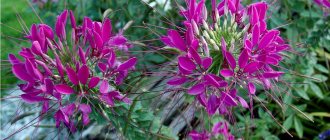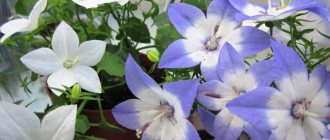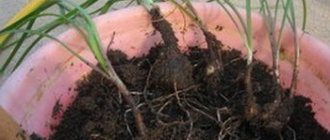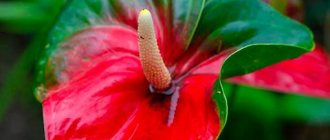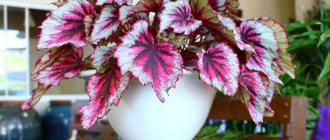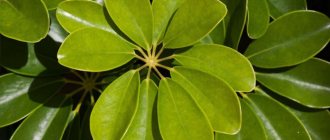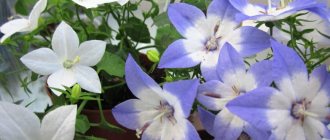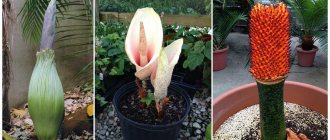The herbaceous plant neomarica (Neomarica) is directly related to the iris or iris family (Iridaceae). In nature, it can be found in the tropical regions of South America. This plant is often called a walking or walking iris. The fact is that it is similar in appearance to a garden iris, and when flowering ends, a baby is formed in the place where the flower was. It is located at the top of a long (up to 150 centimeters long) peduncle. Gradually, under its own weight, the peduncle bends more and more, and at some point the baby finds itself on the surface of the soil, where it very quickly takes root. It turns out that the baby is at some distance from the mother plant, which is why neomarica is called the walking iris.
This herbaceous plant has leathery, flat, sword-shaped leaves of a dark green color. Their length varies from 60 to 150 centimeters, and their width is 5–6 centimeters, and they are fanned out. The formation of peduncles occurs directly on the leaves, and they bear from 3 to 5 flowers. Such fragrant flowers last from 1 to 2 days. They are painted a pale milky color and have bluish veins in the throat, and their diameter can be 5 centimeters. At the end of flowering, the wilted flowers fall off, and in their place a baby (small rosette of leaves) is formed.
Description
Important! The walking iris is characterized by lanceolate, dark green leaves with a length varying from 30 to 160 cm and a width from 1 to 4 cm (depending on the species).
The flower arrow, with its flat shape, visually resembles one of the leaves, but with thickening along the longitudinal axis.
At the end of the arrow there are rather large pale milky flowers with a diameter of 5-10 cm. The lifespan of each of them is no more than a day; over time, a new plant (baby) is formed in place of the withered one. Under its weight, the peduncle bends to the ground, and the baby takes root not far from the mother specimen. Thanks to this method of propagation, neomarica received the name “walking iris.”
This is what the plant looks like in the photo:
The following is a video about the flowering of neomarica:
Main varieties of indoor iris
Neomarica iris is a perennial house flower. The following plant varieties are distinguished:
- slim. It is distinguished by its small size and rich green leaves. Height up to 60 cm;
- northern Lavender inflorescence with flat leaves. The length of the inflorescences is up to 10 cm;
- yellow. A hybrid subspecies characterized by voluminous yellow buds;
- variegated white neomarica. It has variegated leaves with white stripes. The color of the buds is white interspersed with a blue tint.
What does a flower look like
Important! Not all types of plants can be grown at home.
Planting and propagating indoor plants
You can get a new plant by planting baby shoots or sowing seed material. The baby formed at the site of the wilted flower is rooted in another container, with a layer of drainage laid out at the bottom.
- First, the shoot, which has not yet had time to take root, is fixed with a suitable object to the substrate and lightly sprinkled.
- After 2-3 weeks, the young plant takes root and begins to form leaves. At this time, it is carefully separated from the adult specimen, after which the peduncle itself is removed.
Attention! Neomarica obtained from a child begins to bloom 2 years after planting.
When replanting, it is permissible to separate overgrown bushes with several leaf rosettes.
- When removing the mother specimen from the pot, its root system is cut with a sharp knife so that each segment has at least 3 growth points.
- After this, all sections are treated with crushed activated carbon tablets for the purpose of disinfection.
- Each part is placed in a separate pot with a drainage system and a suitable soil mixture.
The seed propagation method is considered ineffective and difficult: only 50% of the planting material germinates.
- Seeds are sown in containers filled with peat-sand or light fertile substrate.
- The containers are covered with polyethylene or glass, with daily ventilation and moistening of the soil as it dries.
- The emergence of seedlings is observed after 2-3 weeks; after the formation of 2-3 leaves, they are picked, planted in separate pots.
Reference. Young plants need to be replanted annually, adults - once every 2-3 years.
There are several options for soil mixtures that are optimal for growing neomarica:
- peat mixture + coconut fiber (3/1);
- turf soil + agroperlite + crushed pine bark (3/1/1);
- peat mixture + leaf soil + agroperlite (1/2/1).
When preparing the soil mixture, it is not recommended to use humus, compost or vermicompost, since these components are unfavorable for the flowering of the walking iris.
Transplanting a plant
Blue pigweed: basics of home care and examples of popular varieties
In order for the plant to develop well, it must be replanted every year in a larger pot. The procedure is carried out as follows:
- Fill the flower pot with plenty of water.
- Wait a few hours.
- Remove the bush from the pot and examine it carefully. If there are putrefactive fragments, they need to be cut off.
- Pour soil mixed with sand into a clean pot.
- Place the flower in the pot and compact the soil.
After this, you need to water the neomarika with plenty of water.
Conditions for growth and flowering
After acquisition, the plant is quarantined, and after about 3 weeks the pot is installed in a permanent place.
Temperature
The temperature of the flower in winter and summer should be different:
- In spring , at the beginning of the growing season, the room temperature should vary from +22 to +25 °C.
- On hot days, frequent spraying and bathing of the plant in the shower is necessary. Also at this time, it is recommended to take the pot out onto an unglazed balcony or into the garden.
- From the beginning of September , the temperature is gradually reduced by installing neomarika on a cool windowsill.
- From the end of November to February, the plant is taken out into an unheated room or onto a glassed-in loggia with a temperature of +8-12 °C.
Important! During the cold period, the flower needs protection from drafts and hypothermia.
In rooms with temperatures below recommended values, pots with plants are placed in sand or dry sawdust. Provided that wintering takes place in a warm room, the walking iris often blooms already in January.
However, the absence of a change of seasons negatively affects the condition of the plant and provokes its rapid depletion. To avoid this, it is necessary that the rest period be at least 2 months.
Lighting
For full growth, the flower needs bright and at the same time diffused lighting.
- In winter, western and southern windows will be a suitable place for it.
- In summer , from approximately 12:00 to 15:00, it is necessary to organize shading in order to protect the plant from direct infrared rays.
Watering
The neomarika watering regime depends on the time of year and indoor climate conditions:
- Early spring - the substrate is moistened regularly, but at the same time allowed to dry out by about ½ volume.
- Late spring, summer - the frequency and abundance of watering is increased, while allowing the top layer of soil to dry to a depth of 3 cm.
- Autumn - the frequency of watering is gradually reduced, drying the soil by ½ volume.
- Winter - the frequency of watering is reduced to a minimum, in this case the soil has time to dry out almost completely.
Attention! The humidity level in the room with the flower must correspond to the temperature, so in the summer a tray with water is placed under the pot and sprayed daily.
Top dressing
Since in nature the walking iris grows on poor soils, when grown in a pot it does not need intensive fertilizing. It is optimal to apply fertilizers from May to June with a frequency of 1-2 times a month. It is recommended to use formulations intended for orchids as fertilizers.
Reproduction methods
The walking iris (neomarica) reproduces in several ways. Each of them has its own characteristics.
Dividing the bush
Alocasia - home care, description of Polly and Amazon varieties
A common option for reproduction. How to carry out the procedure:
- Divide a large bush into parts, plant the resulting branches in different pots.
- Water the plants with plenty of water.
Note! It is worth remembering that for replanting you need to mix the soil with humus.
Rooting of children
Rooting babies is a rare option for propagating neomarica. For this purpose, seeds collected from inflorescences are used. They need to be planted in soil mixed with sand and left in a well-lit room.
Neomarica (walking iris) is a beautiful plant. For its productive growth, it is worth following the rules of care and replanting in a timely manner. This will help avoid serious illnesses.
Pest protection
Neomarica is characterized by resistance to various diseases and pest attacks. However, improper care can lead to flower damage in the following ways:
- fungal diseases;
- aphids;
- spider mite.
To eliminate the problem that has arisen, the perennial is treated with a chemical preparation, and all agrotechnical rules are strictly observed during the care process.
Neomarica is a relatively unpretentious plant: in suitable growing conditions it will delight with its magnificent flowering for many years.
Autumn is the time to plant bulbs
First of all, we suggest you watch a video on the topic:
Planting features depend on the variety. In temperate climates, iridodictiums, Turkish and Caucasian, as well as their hybrids, take root well and tolerate winter. We choose a dry, open place and dig shallow holes - up to 7 cm. We fill the bulbs so that the soil does not adhere tightly to them, and it is better to add a little sand to its composition. To protect plants from fungal diseases, we pre-treat purchased bulbs with Fundazol or Benlat. In the summer, after the stem and leaves die, we separate the small daughter bulbs, which are necessary for further reproduction.
Mistakes and care problems
| Problem | Cause |
| The leaves are curling | The cause of this problem is most often the excessive influence of sunlight on the flower. |
| Mold has formed on the ground | Occurs most often when there is excessive watering and lack of drainage in the pot. |
| The plant does not bloom | This problem most often occurs in the absence of the required amount of sunlight or in the absence of a rest period. |
| The leaves gradually dry out | The cause of the problem is excessively dry air. To eliminate it, you need to moisten it and spray the plant every three days. |
Biological features of irises
Iris is a perennial, herbaceous plant that overwinters in open ground. Its underground organ is the rhizome, which spreads horizontally over the surface of the soil and only partially goes deep. It consists of thickened and shortened segments (links), often reaching a significant size (8-12 cm in length, 2-3 cm in diameter).
In some parts the rhizome grows, in others it slowly dies. Adventitious roots live for 2 growing seasons; at the 3-year stage they are no longer present. At the top of the annual segment of the rhizome, after the peduncle dries out, depressions remain. The age of the plant can be determined by the annual links.
The flower bud is located in the apical part of the leaf bunch (fan) and is formed 3-4 weeks after the end of flowering. Irises bloom intensively next year, which means that in forcing everything is decided by the weather of this period. If the weather is warm and dry in June - early July (for early varieties), the plant will produce more flower buds. In damp and cool weather, fewer buds will form.
Here is very important information from the literature on growing irises, which we initially did not pay attention to and therefore did not receive flowers during forcing in one of the years: flower buds are formed only in fans of 7 or more leaves.
We knew: in order for irises to set flower buds well, we need to pay attention to their growing conditions. From their ancestors, bearded irises inherited a love of warmth and light. They grow best in a place protected from the wind and exposed to the sun with well-drained soil. The sun's rays in the first half of the day are especially beneficial for irises. The upper part of the rhizome (back) must be in the sun. Irises can tolerate light shade from sparse trees, especially during hot midday hours, but they cannot tolerate dense shade at all and stop blooming, although the foliage develops. Irises only need watering during drought; usually they have enough precipitation. The exception is mandatory watering during planting, during budding and fertilizing. Iris is not picky about soil conditions, but grows better in nutrient-rich clay soils.
By providing the above conditions for irises, you can grow good planting material for forcing.
How to avoid mistakes when forcing irises
In the first years of research, we took planting plots from perennial, highly overgrown bushes. Flowering was obtained at home in winter, but it was unstable in different years and with a low percentage of flowering shoots. The explanation for this is that in a large bush the rhizomes are cramped and few leaves are formed, which means that flower buds are poorly formed. This gave us the idea of growing planting material specifically for forcing. Three weeks after flowering, which occurs at the end of June - beginning of July, we divided the perennial bush and planted annual and biennial shoots of rhizomes on the ridges. In September, plants from the ridges were planted in containers (or boxes) and left buried on the ridges until frost. At the beginning of November, the irises were put into the basement (+4°C). During storage, care was taken to ensure that the soil in the vessels did not dry out. They took it out of the basement in the 3rd decade of January and put it in the light in the classroom.
Flowering began at the end of February. The grown annual and biennial shoots bloomed profusely. Ungrown one-year shoots did not bloom at all, and two-year-old shoots bloomed very weakly compared to the grown shoots. Thus, we have experimentally determined that it is better to grow planting material for forcing.
In 1998-1999 We set up another experiment to find out how the age of germinated planting material affects the flowering of forced irises. One-year-old, two-year-old and three-year-old shoots were planted.
We call an annual shoot a juvenile (not yet flowering) shoot of one-year growth (one apical link of the rhizome with a fan of leaves). A two-year shoot is a juvenile shoot of one year's growth with last year's growth (two links). Three-year-old - juvenile shoot of one-year growth with growth of two previous years (three links).
Before planting in forcing vessels, the number of leaves in the fans of each plant was counted. One-year shoots had from 3 to 7. Apparently, the conditions of the summer of 1998 (drought) were not conducive to the growth of leaves. Therefore, flowering in winter was very weak.
Two-year-old shoots had from 5 to 10 leaves. Irises from these shoots bloomed profusely - 80% of them produced peduncles, most plants had 2 peduncles.
Three-year-old shoots bloomed well, but weaker than two-year-old shoots - 70% produced flower stalks and there were fewer flower stalks.
Thus, it turns out that one-year-old shoots, even germinated ones, may not bloom well every year when forced, while growing two-year-old shoots ensures abundant and stable flowering.
Popular types of neomarica
There are more than 15 species of irises in the genus, each of which has characteristic differences. The most common in Russia are neomarica slender and northern. The first type has rather large flowers and is distinguished by a fan-shaped arrangement of foliage. Their length can reach 60 cm and width 5–7 cm.
The leaves of the second plant can reach as much as 90 cm and have a richer green tint. In addition, northern neomarica has a pronounced delicate aroma, which not every iris can boast of.
Find out how and with what to plant irises beautifully.
How to grow irises from seeds
The flowering period of irises in our country lasts from April to mid-July. This does not mean that one variety will delight you for two and a half months; each of them is given no more than 15 days to bloom. Cunning gardeners place several varieties with different flowering periods on the same lawn, admiring the beautiful flowers until mid-summer.
There are never too many irises on the site - you can admire the unearthly beauty of this flower endlessly. It is for this reason that many gardeners prefer to grow iris from seeds. With species irises everything is simple - after the end of the flowering period, carefully pack the box with immature seeds directly on the stem in gauze or synthetic tulle. The seeds ripen until autumn; you may not notice the cracking of the capsule.
Method No. 1
In mid-September, the seeds are planted in the garden bed (planting depth - 2 cm, distance between rows and in the row - 10 cm). To prevent tender sprouts from dying from frost in autumn and spring, they are covered with padding polyester, which will serve as an air cushion.
Feeding neomarica: fertilizers and schemes
Feeding neomariki is carried out only during the active growing season. When choosing a fertilizer, you need to monitor the ratio of nitrogen, phosphorus and potassium (NPK complex), avoiding a large predominance of nitrogen in the composition:
| Fertilizer name | NPK ratio | Preparation and method of feeding | Application diagram |
| "Pokon in sticks for flowering plants" | 8:10:14 | Long lasting fertilizer. Sticks are inserted into the soil in quantities depending on the volume of the pot (on average 1-2 pieces per plant). | Once a year in the spring, after the beginning of the growing season. |
| "Fasco Stimulating Flowering" | 4:4:7 | Liquid concentrate. Diluted with water at the rate of 5 ml per 1 liter of water, applied to the root during watering. | From April to September once every 10 days. |
| "Etisso for flowering plants" | 3,8:7,6:7,6 | Liquid concentrate. Diluted with water at the rate of 1/2 dispenser (5 ml) per 1.5 liters of water. Used during watering, at the root. | From April to September once a week. From October to February once a month. |
The dosages indicated in this table are halved compared to those recommended in the instructions. This should be done with any other selected fertilizers, since neomarica is one of those plants that is better to underfeed than to overfertilize.
Types of irises, some nuances of their cultivation
A common cultivated species of irises includes bearded irises, so named for the soft bristly growths on the lower petals. They are also called “northern orchids”. Siberian irises are graceful, resistant to adverse weather conditions, unpretentious, immune to bacteriosis, and capable of healing soil contaminated with bacteriosis. Japanese (xiphoid iris) are distinguished by their unusual flower shape. The plants are fastidious, require dry wintering (covered with oak leaves, plastic film), slightly acidic soil with uniform, medium moisture during the flowering period. Swamp irises are the most persistent; they grow well near water, in water, on marshy soils, in dry places. The lifespan of the swamp iris is about 8 years. At the same time, it does not require any maintenance at all.
Disease and pest control
Diseased plants are recognized by spots on the leaves, wilting, and a small number of buds. Fungal infections can be controlled by using fungicidal solutions. Plants should be treated for diseases three times with an interval of 7-10 days. Among the drugs that will be effective are “Fundazol”, “Fitosporin-M”, “Quadris”.
If bacteria have infected the root system of irises, it is better to dig up the plant and examine the bulb. Damaged areas are cut off with a sharp knife, and the bulbs are washed in a concentrated solution of potassium permanganate. The sun's rays work well against bacteria.
It is necessary to rake the soil around the stem and leave it under the influence of ultraviolet radiation for several days.
Caterpillars of cutworm butterflies attack the leaves of irises. Voracious larvae can leave plants without leaves and flower stalks. The drug "Granozan" helps save irises from butterflies. Thrips accumulate in the leaf axils, causing enormous damage to ornamental crops. They are fought with the help of treatment with Karbofos. In rainy summers, slugs plague flower plantings. To protect against them, you should sprinkle the soil between the rows with superphosphate or wood ash.


